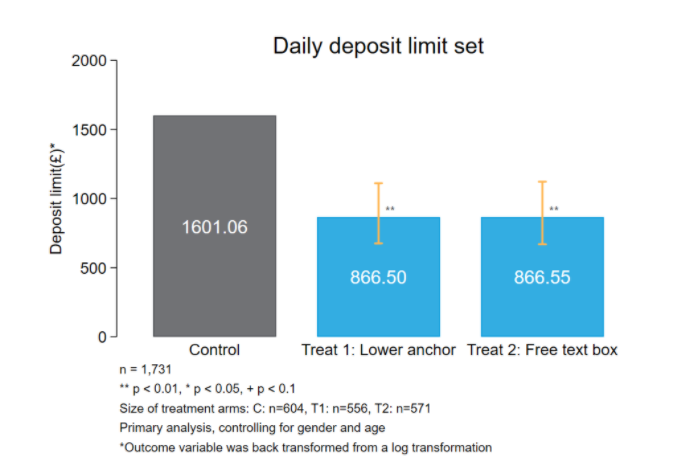The Behavioural Insights Team has today launched its new report on how to improve the industry-standard safer gambling tools that are designed to help people control how much they spend. We found that people who gamble reduce their spending limits by almost half once industry-set options are removed from view. This report follows our initial research into whether behavioural insights can reduce risky play in online environments.
Background
Great Britain is home to the biggest regulated gambling market in the world. Indeed, if you were to encounter a British adult at random, the chances are almost 50:50 that they would have gambled, including on the National Lottery, in the last four weeks.
Of those who gamble, a small but significant proportion are considered ‘at risk’ of developing severe gambling issues. For others, the consequences of their gambling are so serious and frequent that they meet a clinical threshold of ‘problem gambling’. This is not only detrimental to the individual’s financial and mental wellbeing; the harmful effects are passed on to close friends and family members.
Our safer gambling work
In 2017, the Behavioural Insights Team was commissioned by GambleAware to explore whether behavioural science could help to reduce risky gambling. The first phase of our research showed that applying behavioural insights, even as small changes, can have a substantial impact on the uptake of safer gambling tools. Our latest work goes a step further and asks how these tools can be made more effective.
Anchoring and deposit limit tools
Deposit limits are one type of safer gambling tool, and are a common feature on British gambling platforms. They are used to cap the amount of money that someone is able to deposit each day, week or month. Customers are typically required to scroll through a dropdown menu of pre-defined options, such as £10,000, £5,000, £1,000 and £5, to find the value they wish to select. The options usually begin with the largest deposit limit available, which in some cases can be as high as £100,000.
A key principle in behavioural science is that our choices tend to be influenced by a suggested reference point. This effect, known as ‘anchoring’, has been researched extensively in the context of charity donations, where the presence of a higher or lower anchor has been shown to influence the size of subsequent donations.
Given we know that this anchoring bias exists, the presence of pre-set options in deposit limit tools has clear behavioural design implications. We wanted to examine whether exposure to larger values might influence customers to set higher deposit limits for themselves than they otherwise would.
Our trial
In the first field trial of its kind, we worked with major British gambling operator bet365 to test two variations against the business-as-usual approach. In one variation, deposit limits options were presented with lower values, the largest being £250. In the other, there were no values at all. Participants were instead asked to set a deposit limit using a free text box. bet365 customers were allocated randomly between these three groups: (1) control — business-as-usual with anchors as high as £100,000; (2) low anchors — up to £250; and (3) no anchors.
Key findings
Our first analysis measured the size of the initial deposit limit set by customers across each of the three trial arms. The results were profound. We found that removing high anchors from view led to an estimated reduction in the size of chosen deposit limits of around 45%.

We were also interested in whether setting lower deposit limits would have an effect on how much money was actually deposited. We estimated that on average, an individual in the control group deposited £445 over 30 days. We estimated that the same individual would deposit 4.4% less into their account (£426) over the same time period if exposed to lower anchors, and 18% less (£360) if given a free text box to set a deposit limit. However, these findings were not statistically significant, meaning that we cannot rule out that they were due to chance. Repeating the work with a larger group of customers would help us to answer this.
Our recommendations
Only last month, the UK government announced a major and wide-ranging review into the 2005 Gambling Act, described as “an analogue law in a digital age”. Our work continues to show the profound impact that behavioural insights can have on modernising the regulatory landscape and creating better, easier to access, safer gambling tools for consumers.
We offer three key recommendations based on this trial’s primary findings:
- Customers should be presented with a free text box with no visible or suggested minimum/maximum values when setting deposit limits. We recommend that this be implemented across the industry as part of social responsibility code provisions under the Gambling Commission’s License Conditions and Codes of Practice (LCCP).
- Operators should apply known effective methods to increase uptake of deposit limits, continue to test what works, and share those insights. Our previous work demonstrated that making it easier for people to access deposit limit tools increases uptake. We therefore recommend that operators carry out testing into how best to prompt customers to set meaningful limits.
- More research funding must be directed towards causal evaluations that will yield insights to inform policy and be scaled across the industry. Much more work is needed to test the impacts of various features of online gambling using randomised controlled trials in live business environments. Only then will robust, independent evidence exist to inform policies, practices and procedures.






